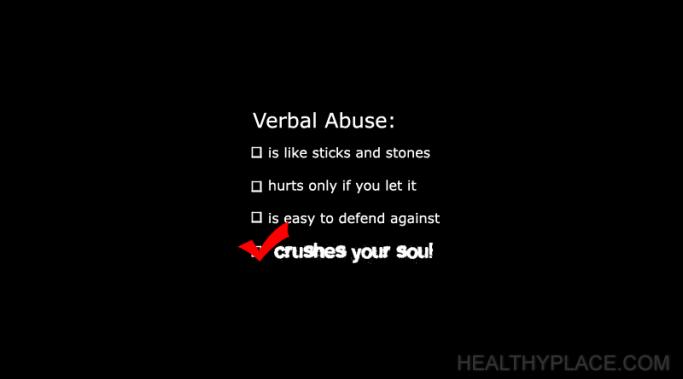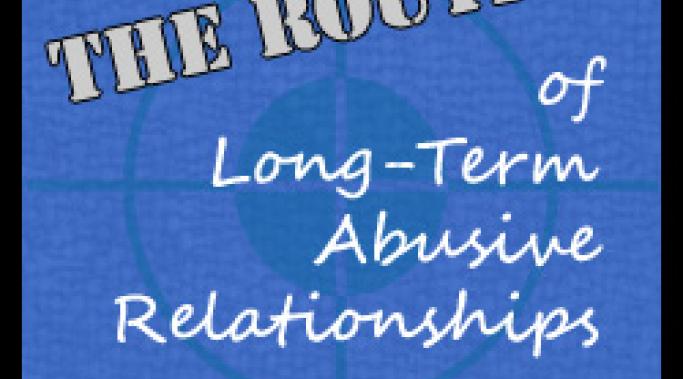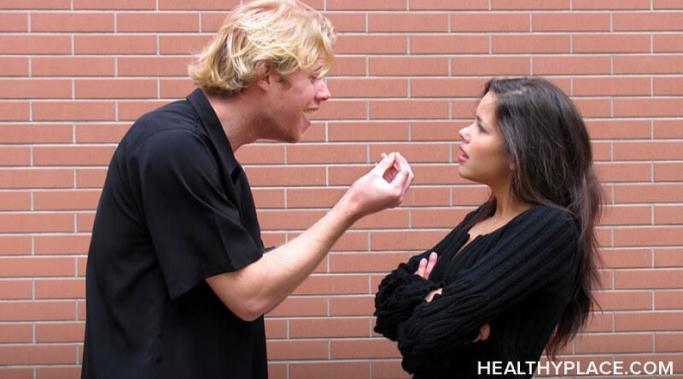A verbal abuse quiz can do a lot of things. It can help you determine if you suffer from verbal abuse. It can change your mind about what verbal abuse is and is not. A verbal abuse quiz can even show you that (eek!) you abuse other people. But a quiz cannot make you be honest. So if you are not ready to take an honest look at your situation, then don't bother with this verbal abuse quiz. It can't help you if you lie.
Signs and Symptoms of Abuse
The effects of verbal abuse hurt me in both the short-term and long-term. Short-term effects of verbal abuse were the sting of his words or suggestions and the long nights spent crying silently to myself, figuring out what I needed to do to make the relationship better. Long-term effects, for me, are posttraumatic stress disorder and major depressive disorder. Some victims of abuse suffer dissociative identity disorder, too.
How does that happen? Why does a healthy person become a victim suffering from mental disorders?
Years ago, I bore two sons into my abusive marriage. Young and naïve, I thought my husband would change into a loving man when he felt unconditional love from and for the children. I thought that real love would end his cruelty toward me, and that he and I would create a loving family. I thought wrong.
The prior post discussed the relationship between the abuser and victim, then explored what each partner thinks during the routine. This post digs into the abusive relationship feelings and behaviors of the victim and abuser during a long-term abusive relationship.
The routine merges the cycle of violence and abuse phases of the honeymoon and tension-building, and it develops over a period of time. Typically we see the routine only in long-term abusive relationships because it enables both victim and abuser to manage their diseased relationship without expending as much emotional, mental, or physical energy as they did when the relationship was new. (The routine is also covered in this post on the routine and cycle of violence and abuse.)
The cycle of violence and abuse typically consists of three phases: tension-building, abuse, and honeymoon. The first two phases describe themselves and the honeymoon phase occurs after the abuse and gives the abuser a chance to beg the victim's forgiveness or otherwise convince the victim to stay. Over time, the tension-building and honeymoon phases tends to shorten or disappear, leaving us to wonder why abusive relationships can last so long. This routine makes staying in an abusive relationship manageable; both victim and abuser come to accept this routine as normal.
We tend to speak of the cycle of violence and abuse as if it were a constantly turbulent system, but we rarely discuss the routine that makes it easier to stay in an abusive relationship, the mind game that soothes the volatile system into manageability. The wheel of violence and abuse shows the cycle concisely, but too narrowly. The wheel shows the cycle as a rolling circle of abuse, honeymoon, tension-building, abuse, honeymoon, tension-building, abuse -- visually repeated infinite times with arrows circling around the wheel until we say to ourselves, "I get it! It's so simple." But then we feel shocked that victims of abuse don't just leave. After all, the wheel makes the cycle of violence and abuse so transparent that victims 'should be able to leave.' Despite its powerful (and necessary) message, the wheel simply cannot tell the whole story.
Description of A "Toxic Ex"
A toxic ex is any co-parent who creates a loyalty conflict for your child(ren). Loyalty conflicts occur when your child believes they must choose one parent over the other.
A toxic ex will do things like:
Restrict or hinder communication and/or contact between you and your children.
Talk badly about you to your children.
Erase and Replace You (This phrase comes from Co-parenting with a Toxic Ex and means to ". . . erase you from your child's heart, mind, and memory and install someone else . . .").
Undermine you.
Persuade your kids to not trust you and urge them to betray your trust (the "divide and conquer to maintain control" routine).
Last year, I did a top ten list of the most viewed Verbal Abuse in Relationships blog posts, so I thought I'd do something different this time. The posts on this list earned the largest percentage of comments per times viewed. If you missed them, perhaps you want to add your two cents. Readers tell me all the time they get as much from the comments as they get from the post, so share your experience so we can ALL benefit!
I tried to write this post earlier today, but evidently there were some comments and stories I needed to read first. Stories from addicts, ministers and other abuse survivors reminded me of how much I used to fight my abuser. I fought with my ex-husband so often that I accepted some isolation to spare myself the embarrassment of fighting in front of his friends. At the end, I think every one of the people my ex hung out with knew that I couldn't stand to look at him.
No wonder they believed his stories that I was miserable and unstable. I couldn't open my mouth without something negative about my ex sliding out. My feelings for him surrounded me like a prickly heat and they made me seem like someone I was not. Ugly. Hateful. Mean. My feelings for my ex made it easy for his friends to feel sorry for him, give him a place to stay, and believe his side of whatever story he told.









